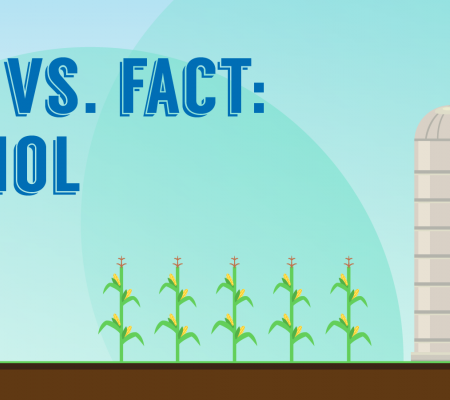Ask anyone on the street what they “know” about biofuels, alternative energy, or anything in the environmental realm, and you’re bound to get a slew of very different answers. Many of these answers will contradict each other. Some may contradict common sense.
As with any growing field of technology or science - especially one with potential to overturn a century-old economic status quo - advances in alternative fuels and energy come with their fair share of misinformation and myths. Dispelling these myths is going to take more than a blog post. That’s why we’re posting several - a whole series - on the myths and facts of alternative fuel sources.
Today, we’re talking about ethanol.
Here are the basics. Ethanol is a renewable fuel made by processing various plant materials known as “biomass.” Ethanol isn’t only made from corn, as it overwhelmingly is here in the States. In Brazil, the world’s leading producer of the fuel, ethanol is made primarily of sugarcane. It can also be made from grasses, sorghum, even trash. Ethanol is then added to gasoline to oxygenate the fuel, enhancing combustion and reducing air pollution. Most petroleum based gasoline in the U.S. contains up to 10% ethanol already. Chances are, you put some in car your car the last time you filled up. Flex fuel vehicles run on blends up to 85% ethanol. Those are the basics. Here are some things you may not know:
MYTH
Ethanol is made from corn that should be used for food.
FACT
Corn used for ethanol is not the same corn you grill for Fourth of July barbecues. No amount of butter-slathering is going to make it palatable - or digestible for humans. The corn used for ethanol production is called No. 2 yellow field corn, and is kind of like the No. 2 pencil of agricultural crops. It serves many useful purposes, but you wouldn’t want to put it in your mouth. There is a kernel of truth to this one though, as No. 2 yellow field corn does make its way into livestock feed. However, advances in the ethanol production process yield byproduct proteins and nutrients that can be used in animal feeds.
MYTH
Increasing the amount of corn used for ethanol will lead to deforestation.
FACT
As the agricultural industry continues to advance its technology and practices, crop yields increase in efficiency. Compared to the 1930s, farmers today use 20% less land to produce larger amounts of corn. Combine that with improved efficiency in the ethanol production process, and today we get a lot more ethanol bang for our land resource buck.
MYTH
Producing enough ethanol for fuel leads to food shortages and increases the price of food.
FACT
From field to table, the food industry is an incredibly complex web subject to an incalculable array of social, economic and environmental influences. Nearly 96% of increases in the price of food can be attributed to factors other than ethanol production, such as weather, trade policies and population trends.
MYTH
Ethanol doesn’t help the environment.
FACT
Ethanol produces fewer harmful emissions compared to gasoline. Studies differ as to how much ethanol reduces greenhouse gas emissions, but show - well-to-wheel - it can reach 59%, depending on the ethanol source and the process used to produce it. That percentage continues to increase as we advance our methods and technology. Cellulosic ethanol reduces emissions more effectively than more readily available ethanols, those made from corn for example, although they are currently more difficult to process into useable fuel.
MYTH
It takes more energy to make ethanol than it provides.
FACT
When the ethanol industry was in its infancy, this was true to an extent. Fortunately, innovation on the part of both the farmer and manufacturer have led to much greater efficiency and higher net energy yields. Studies have shown that ethanol provides 67% more energy than it takes to produce.
MYTH
Ethanol is bad for my vehicle.
FACT
Ethanol is readily available, burns cleaner, reduces emissions and helps keep engines clean. Most gasoline in the United States contains up to 10% ethanol and most vehicles made after 1980 can run on even higher blends. Fuel flex vehicles are specially designed to run on blends up to 85%.
In conclusion, ethanol is not the be-all-end-all solution to our fuel dilemma, in the U.S. or anywhere else in the world. It presents challenges, but also choice, and choice is very important when it comes to empowering the average person with the ability to make positive environmental impacts.
And while it’s not perfect, ethanol is a bridge to more progress. The potential for a cellulosic ethanol promises greenhouse gas emission savings of up to 88% - using non-digestible sources such as switchgrass, wood chips, or byproducts of landscaping maintenance rather than harvested sugars and starches such as corn or sugarcane. However, cellulosic ethanol makes up a tiny - but growing - fraction of total ethanol produced in the U.S., so there is plenty of room for improvement in the industry.
Alternative fuels are important stepping stones in breaking our dependence on fossil fuels and cleaning up our air. To learn more about ethanol and other alternative fuels, check out our interactive infographic.
